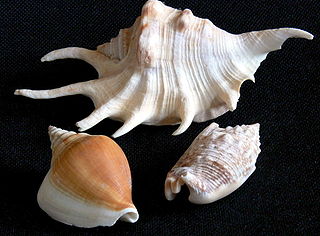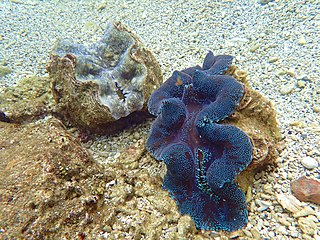The Miocene is the first geological epoch of the Neogene Period and extends from about 23.03 to 5.333 million years ago (Ma). The Miocene was named by Scottish geologist Charles Lyell; the name comes from the Greek words μείων and καινός and means "less recent" because it has 18% fewer modern marine invertebrates than the Pliocene has. The Miocene is preceded by the Oligocene and is followed by the Pliocene.

Strombidae, commonly known as the true conchs, is a taxonomic family of medium-sized to very large sea snails in the superfamily Stromboidea, and the Epifamily Neostromboidae. The term true conchs, being a common name, does not have an exact meaning. It may generally refer to any of the Strombidae but sometimes is used more specifically to include only Strombus and Lambis. The family currently includes 26 extant, and 10 extinct genera.

Bulinus is a genus of small tropical freshwater snails, aquatic gastropod mollusks in the family Bulinidae, the ramshorn snails and their allies.

Tridacninae, common name the giant clams, is a taxonomic subfamily of very large saltwater clams, marine bivalve molluscs in the family Cardiidae, the cockles.
Europrotomus is an extinct genus of fossil sea snails, true conches, marine gastropod mollusks in the family Strombidae, the true conchs.

Persististrombus coronatus is an extinct species of fossil true conch from the Late Miocene to Pliocene.
This list, 2012 in molluscan paleontology, is a list of new taxa of ammonites and other fossil cephalopods, as well as fossil gastropods and bivalves that have been described during the year 2012.
This list, 2013 in molluscan paleontology, is a list of new taxa of ammonites and other fossil cephalopods, as well as fossil gastropods, bivalves and other molluscs that have been described during the year 2013.
This list, 2014 in molluscan paleontology, is a list of new taxa of ammonites and other fossil cephalopods, as well as fossil gastropods, bivalves and other molluscs that have been described during the year 2014.
This list, 2015 in molluscan paleontology, is a list of new taxa of ammonites and other fossil cephalopods, as well as fossil gastropods, bivalves and other molluscs that have been described during the year 2015.

Persististrombus nodosus is an extinct species of fossil sea snail, a marine gastropod mollusk in the family Strombidae, the conchs.

Persististrombus radix is an extinct species of fossil sea snail, a marine gastropod mollusk in the family Strombidae, the conchs.
This list, 2017 in paleomalacology, is a list of new taxa of ammonites and other fossil cephalopods, as well as fossil gastropods, bivalves and other molluscs that are scheduled to be described during the year 2017, as well as other significant discoveries and events related to molluscan paleontology that are scheduled to occur in the year 2017.

Austromola is an extinct genus of ocean sunfish. It contains a single species, A. angerhoferi, known from the Lower Miocene Ebelsberg Formation near Pucking, Austria. It is thought to be the sister taxon to Mola and Masturus.
The Gomphotherium land bridge was a land bridge that connected Eurasia to Afro-Arabia between approximately 19 Mya and 15 Mya.
Kermia bulbosa is an extinct species of sea snail, a marine gastropod mollusk in the family Raphitomidae.
This list 2020 in paleomalacology is a list of new taxa of ammonites and other fossil cephalopods, as well as fossil gastropods, bivalves and other molluscs that are scheduled to be described during the year 2020, as well as other significant discoveries and events related to molluscan paleontology that are scheduled to occur in the year 2020.

The Santa Cruz Formation is a geological formation in the Magallanes/Austral Basin in southern Patagonia in Argentina and in adjacent areas of Chile. It dates to the late Early Miocene epoch, and is contemporaneous with eponymous Santacrucian SALMA. The formation extends from the Andes to the Atlantic coast. In its coastal section it is divided into two members, the lower, fossil rich Estancia La Costa Member, which has a lithology predominantly consisting of tuffaceous deposits and fine grained sedimentary claystone and mudstone, and the upper fossil-poor Estancia La Angelina Member, which consists of sedimentary rock, primarily claystone, mudstone, and sandstone. The environment of deposition is interpreted to have been mostly fluvial, with the lowermost part of the Estancia La Costa Member being transitional between fluvial and marine conditions. The environment of the Estancia La Costa Member is thought to have been relatively warm and humid, but likely became somewhat cooler and drier towards the end of the sequence. The Santa Cruz Formation is known for its abundance of South American native ungulates, as well as an abundance of rodents, xenarthrans, and metatherians.
Th Quilon formation is a geologic formation existed in South West coast of India. The Quilon formation, along with Warkalli formation represent sediments laid down in the Kerala basin that existed during Mio-pliocene times. The Quilon formation of the Miocene age is made up of limestone, and the Warkalli formation is made up of alternating beds of sand and shale exposed along the Varkala cliffs.







